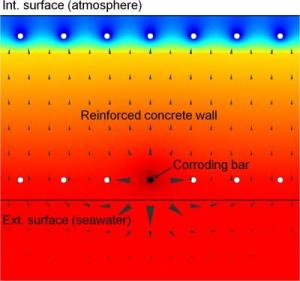Dec 19 2013
Using numerical modeling, an Italian research team has discovered the role 'macrocells' play in the corrosion of hollow submerged marine concrete structures such as tunnels and parking structures.
 This schematic shows the effects of a macrocell between a corroding reinforced steel bar (black dot) and non-corroding bars (white dots). The arrows depict the electric current circulating between the bars, while the colors show the variation of the electrochemical potential in the concrete wall (blue for high potential or red for low potential).
This schematic shows the effects of a macrocell between a corroding reinforced steel bar (black dot) and non-corroding bars (white dots). The arrows depict the electric current circulating between the bars, while the colors show the variation of the electrochemical potential in the concrete wall (blue for high potential or red for low potential).
In marine environments, chloride-induced corrosion of steel can quickly take a toll on hollow submerged structures such as tunnels or parking structures by degrading their concrete and reinforced steel bars. This is a serious problem, given the high cost associated with building these structures and the fact that regular maintenance and restoration activities can prove quite challenging.
A research team in Italy used numerical modeling to explore chloride-induced corrosion and its impact on hollow submerged marine concrete structures. They describe their findings, including the role of the "macrocell" phenomenon, in a paper published in CORROSION journal.
"Chloride-induced corrosion occurs within the presence of chloride, which is commonly dissolved in seawater, and oxygen on a steel surface," explains Federica Lollini, assistant professor, Department of Chemistry, Materials, and Chemical Engineering, Politecnico di Milano. "This means that reinforced concrete structures exposed to the tidal zone—in which wetting and drying cycles bring chloride and oxygen into contact with steel surfaces—are more prone to chloride-induced corrosion than those completely submerged in seawater, in which oxygen concentrations are low."
For the type of hollow submerged marine structures the researchers focused on, chlorides contaminate only the external side of the wall in contact with seawater, while oxygen is present only in the internal wall in contact with the atmosphere.
"Under these conditions, a phenomenon called 'macrocell' can occur," says Lollini. "Macrocells involve the circulation of an electric current between the reinforcing bars in the external side of the wall and those in the internal one, and it can lead to chloride-induced corrosion in submerged structures."
While macrocells may, in theory, greatly influence the development of corrosion in these types of reinforced concrete structures, their effects tend to be neglected by designers due to a lack of knowledge about this phenomenon, according to Lollini and colleagues.
So they decided to zero in on the effects of macrocells through numerical models, which are able to simulate the behavior of real structures, as long as the appropriate electrochemical parameters are used to describe the phenomenon. Their models confirmed that the effects of macrocells shouldn't be neglected.
"Macrocells may trigger chloride-induced corrosion and increase its speed, which means it may significantly reduce the duration of the service life of submerged hollowed structures," Lollini says.
These findings may ultimately lead to the development of appropriate design criteria for hollow reinforced concrete structures submerged in seawater. "Our numerical models can serve as the starting point for further simulations aimed at exploring the effectiveness of electrochemical techniques that can be applied to submerged structures to prevent the initiation of corrosion or to lower the steel corrosion rate if it's already begun," notes Lollini.